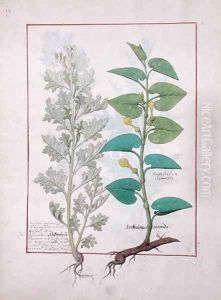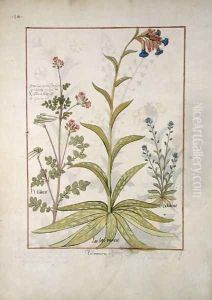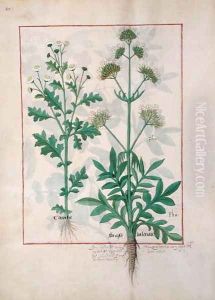





Top row- Yellow Bugle, Incensaria and Lupius. Bottom row- Dogs Mercury, Lily Leek and Lentilles, illustration from The Book of Simple Medicines, by Matteaus Platearius d.c.1161 c.1470
-
About Reproduction
Discover the allure of art with our faithful reproduction of "Top row- Yellow Bugle, Incensaria and Lupius. Bottom row- Dogs Mercury, Lily Leek and Lentilles, illustration from The Book of Simple Medicines, by Matteaus Platearius d.c.1161 c.1470", originally brought to life by the talented Robinet Testard. Unlike posters or prints, our hand-painted oil painting breathes an unique sense of depth and texture into your space. Every detail, every stroke, and every texture is meticulously recreated, paying the perfect homage to Robinet Testard and his artistic vision.
Owning this piece is more than just decoration - it's a statement of your refined taste in art. Let the vibrant colors and intricate details of this replica serve as a daily reminder of the beauty in our world. Elevate your decor and appreciate the richness of art with our replica of this masterpiece.
-
Painting Description
The illustration from "The Book of Simple Medicines," attributed to Matteaus Platearius and dated circa 1470, is a remarkable example of medieval botanical art. This particular illustration, created by Robinet Testard, showcases six distinct plants, meticulously detailed and labeled. The top row features Yellow Bugle, Incensaria, and Lupius, while the bottom row includes Dogs Mercury, Lily Leek, and Lentilles.
"The Book of Simple Medicines," also known as "Liber de Simplici Medicina," is a significant medieval text that compiles knowledge about medicinal plants and their uses. Matteaus Platearius, who passed away around 1161, is credited with the original compilation of this work. The book served as an essential reference for physicians and herbalists during the Middle Ages, providing detailed descriptions of various plants and their therapeutic properties.
Robinet Testard, an illuminator active in the late 15th century, is known for his detailed and vibrant illustrations. His work on this manuscript exemplifies the intricate artistry and scientific curiosity of the period. Each plant in the illustration is depicted with careful attention to detail, allowing for easy identification and study. The Yellow Bugle, known for its medicinal properties, is illustrated alongside Incensaria and Lupius, each plant rendered with botanical accuracy. The bottom row continues this detailed representation with Dogs Mercury, Lily Leek, and Lentilles, each plant contributing to the comprehensive nature of the manuscript.
This illustration not only serves as a visual aid for the identification and study of medicinal plants but also reflects the broader context of medieval medicine and the transmission of botanical knowledge. The collaboration between Platearius' textual descriptions and Testard's visual interpretations exemplifies the interdisciplinary approach to science and art during the medieval period. The manuscript remains a valuable historical document, offering insights into the medical practices and botanical understanding of the time.
-
Lead Time & Shipping
When you order this oil painting replica, it typically takes 2-3 weeks to paint. If the artwork is more complex, it might need a little more time to ensure the best quality. Once it's ready, we'll send you a photo for your approval. After you give the green light, we'll ship it to you for free.
-
Return & Refund
We believe in the quality of our hand-painted oil painting reproductions, and your satisfaction is our priority. If for any reason, you are not completely satisfied with your purchase, we offer a 45-day return policy. You can return your artwork within 45 days of receipt and receive a full refund. Please note that the artwork must be returned in the original packaging and in the same condition as it was received.




















